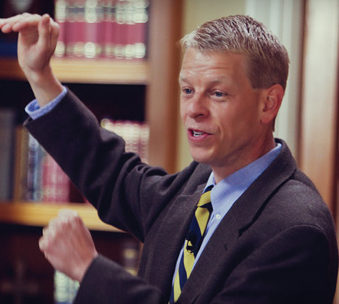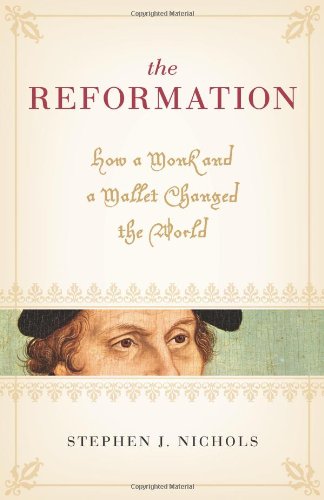Greetings! And welcome to Books At a Glance. I’m Fred Zaspel, and in honor of this 500th anniversary year of the Protestant Reformation we’re interviewing various church historians to track out the story for us in broad strokes and in bite-sized pieces. Today we’re talking to Dr. Stephen Nichols, a long-time friend to us here at Books At a Glance, now the President of Reformation Bible College. He’s also the author of many excellent books, including The Reformation: How a Monk and a Mallet Changed the World.
Steve, welcome! Great to have you with us.
Nichols:
Oh, it’s my pleasure, I look forward to a great conversation about the Reformation!
Zaspel:
Why was the Reformation important? Why do we need to remember it today?
Nichols:
I think you can say a lot of things about the Reformation. Let me boil it down to three main ideas and three main points that I think are important for us. The first two have to do with the content of the Reformation. We often hear of the five solas of the Reformation, and that first sola is sola Scriptura, that Scripture alone is the church’s authority. That is so crucial. The church, in the beginnings of the 16th century had lost its way. There were the trappings of the culture over the centuries, there were the traditions that had stacked up, one upon another, that ultimately obscured the biblical text, and tragically obscured the Gospel. One of the fascinating moments is in 1516. Erasmus produces the Greek text from the printing presses at Basel, and a copy of that text makes its way into Martin Luther’s hands. So this is not a coincidence that in 1516 Luther is looking at the Greek text of the New Testament, and in 1517 he’s posting the 95 theses. Then as you look at the Reformation and as it develops over the 16th century, the word of God was absolutely central and essential. That’s number one, sola Scriptura. The church of every age is in danger of losing the centrality and essentiality of the Scriptures; so we must look to the reformers and we learn that from the reformers.
The second piece of the content is the doctrines of grace. We sum this up with sola Fide, sola Gratia, and solus Christos, that salvation is by faith alone, that it is by grace alone, and that it is in Christ alone. Of course, that’s the Gospel. The gospel doctrine of justification by faith alone that reminds us that it’s not by our works, it’s not by our merits, it’s not by anything that we do, but it’s God’s gracious act of saving us through the redemptive work of the Son. So, again, there’s a place where even, sadly, in our own day, in contemporary evangelicalism, there are those who want to move away from the doctrine of justification by faith alone as essential and central. Really, that’s the Gospel, and that’s at the center of the church’s mission and the church’s identity.
So those are two pieces of content – the authority of Scripture and the articulation, the biblically faithful articulation and proclamation of the Gospel. But the third reason that I think the reformers are important, why we should remember them, and even how they can be a helpful model to us is, not only did they hold those doctrines and teach that content, but they held those doctrines with a firm conviction, and there was a courage, and there was a boldness. When Luther stood up at the Diet of Worms and he made his famous “here I stand” speech, it was essentially Luther contra mundum; it was Luther against the world. He was standing against Emperor, and the nobility, and the princes; he was standing against the Pope. The Pope wasn’t there, but there were officials from the Vatican there, the papal legate was there, bishops in high clergy, and then there’s Luther. And when he took that stand, “Here I stand. My conscience is captive to the word of God. I can do no other,” that was a boldness, that was a courage. We see it in William Tyndale and his efforts to bring the Bible to the English-speaking world, we see it in Luther, we see it in John Calvin, we see it in John Knox, we see it in the women of the Reformation, we see it in Lady Jane Grey and her martyrdom. We just see a courage, a boldness that not only are these the doctrines that we need to proclaim, but as Luther says in his A Mighty Fortress is Our God, “the body they may kill.” That’s what’s at stake here. That’s what was at stake in the 16th century.
I love going back to the Reformation, looking at the reformers, because they just remind us of what it means to be courageous and bold and confident in our convictions, and I think the church of every age needs that.
Zaspel:
The Reformation is often referred to as a period of revival. Do you think that’s a good characterization?
Nichols:
I do. I think any time that you are letting the word of God sink in and permeate, that it is going to have an awakening effect. We have this tendency towards lethargy; we have this tendency towards, as mentioned earlier, obscuring the gospel, and we just need to know that it’s in the word of God that the power of God is unleashed in lives. And the more we see the word of God saturating our lives, the more we’re going to see it at work.
Zaspel:
Why was the Reformation needed? What were some of the critical questions being asked at the time of the Reformation?
Nichols:
I find this a fascinating way to get at the Reformation – there was a painting by Hieronymus Bosch. He’s an interesting, sort of surrealist painter in the 16th century. He dies in 1516, just on the eve of the Reformation. One of his last paintings was a painting called The Haywain, or The Hay Wagon triptych. A triptych is a three panel painting; these are very typical, medieval works of art. On the one side of the panel is Creation and the Fall, and on the third panel, the far panel, is the last Judgment, and in the center is our contemporary life. There’s this oddly shaped, oversized hay bale that’s at the center and there’s all these people who are eating from it, the nobility, the priests. And then you see the masses, the population, and they’re sort of cut off from the hay bale. But here’s what’s interesting, Bosch has Christ up above the hay bale, looking down, and no one’s looking at him. And there’s an angel standing there on the hay bale, pointing up to Christ, and no one’s paying any attention. And as I look at that, I thought that really captures the moment, doesn’t it? That there was this power in the priesthood, there was this power in the hierarchy of the church, there was the power of the nobility, and the masses suffered through all that, but really, what’s going on here is Christ is obscured, the Gospel is obscured. We often hear the Reformation theme of “After Darkness, Light.” What that painting depicts for me is the true essence of the darkness that preceded the Reformation.
Zaspel:
Okay, to borrow from the subtitle of your book, just how did a monk with a mallet change the world
Nichols:
As R.C. Sproul likes to say, one hammer or one mallet in the hand of an obscure, Augustinian monk really did change the world. You think about this, Luther’s posting these 95 theses… So he drafts the 95 theses and he posts them on the church door at Wittenberg. This was a typical thing to do to spark a scholarly debate, that’s what he wanted. And, not only does it cause a stir in Wittenberg, it’s the hammer and nail that’s heard around the world. Think of how the world changed through the Protestant Reformation and the onset of Protestantism in the rise of the modern nation/state that comes out in the 16th century. It’s not just as a significant moment in church history; this is a significant moment in world history.
Zaspel:
We’re talking to Dr. Stephen Nichols about the Protestant Reformation. He is the author of The Reformation: How a Monk and a Mallet Changed the World – as well as many other church history related books that you’ll want to check out on this page. Join us next time when Steve returns to talk about the Renaissance and Erasmus, and their connection to the Protestant Reformation.
Steve, many thanks for talking to us!
Nichols:
Oh, my pleasure, I enjoyed the time.
Editor’s Note: Below are some titles by Dr. Stephen J. Nichols that will be of interest to you!
The Reformation: How a Monk and a Mallet Changed the World
Paperback
Kindle
Martin Luther: A Guided Tour of His Life and Thought (Guided Tour of Church History)
Paperback
Kindle
The Church History ABCs: Augustine and 25 Other Heroes of the Faith
Paperback
Kindle
Welcome to the Story: Reading, Loving, and Living God’s Word
Paperback
Kindle
Jesus Made in America: A Cultural History from the Puritans to “The Passion of the Christ”
Paperback
Kindle
For Us and for Our Salvation: The Doctrine of Christ in the Early Church
Paperback
Kindle
Ancient Word, Changing Worlds: The Doctrine of Scripture in a Modern Age
Paperback
Kindle
Pages From Church History: A Guided Tour of Christian Classics
Paperback
Kindle
Heaven on Earth: Capturing Jonathan Edwards’s Vision of Living in Between
Paperback
Kindle
J. Gresham Machen: A Guided Tour of His Life and Thought (Guided Tour of Church History)
Paperback
Kindle
An Absolute Sort of Certainty: The Holy Spirit and the Apologetics of Jonathan Edwards
Paperback

